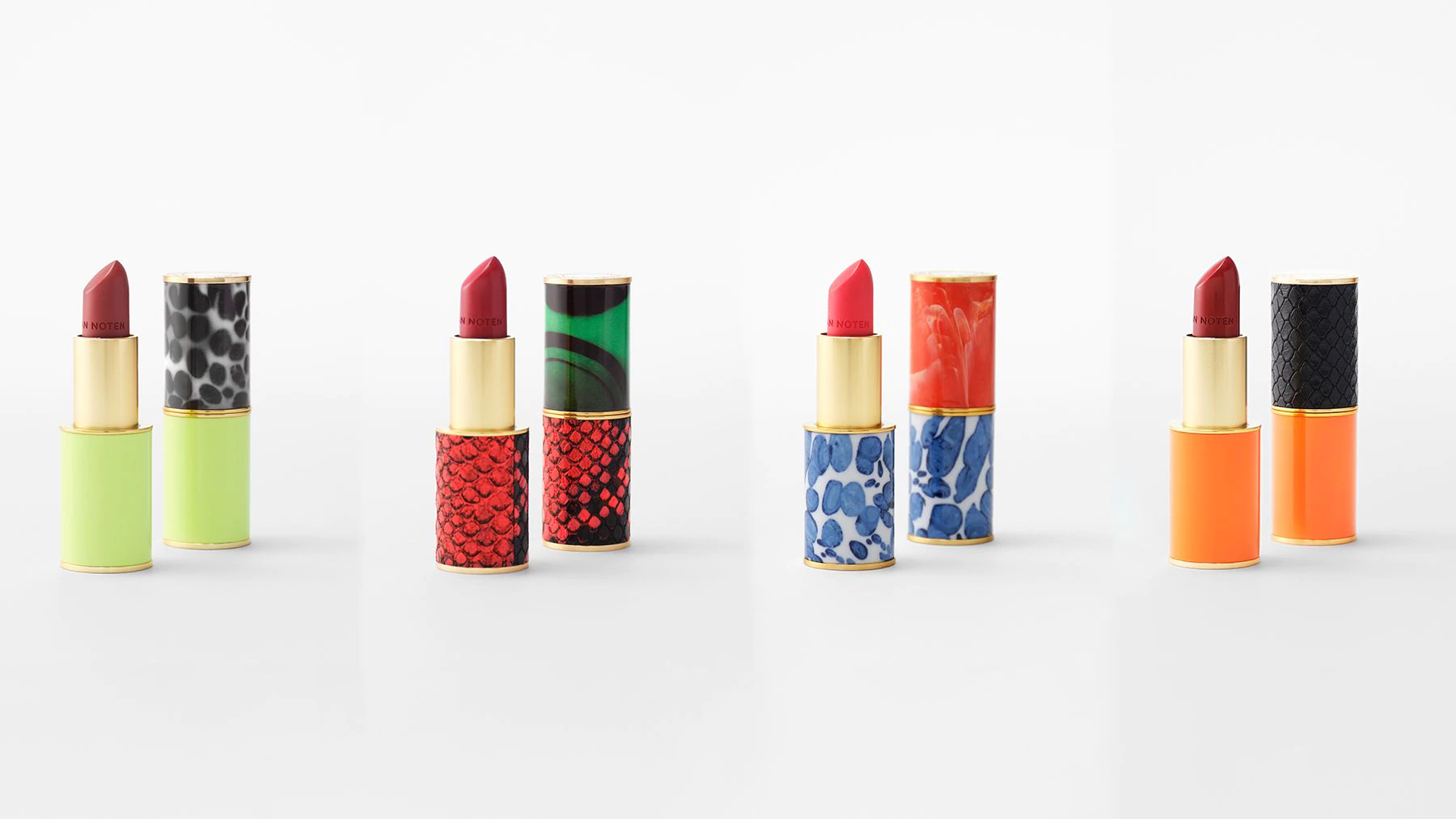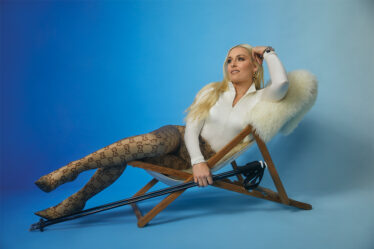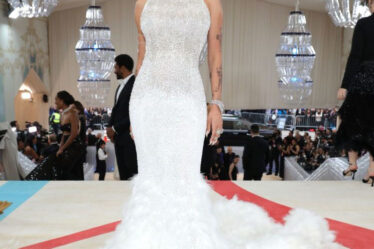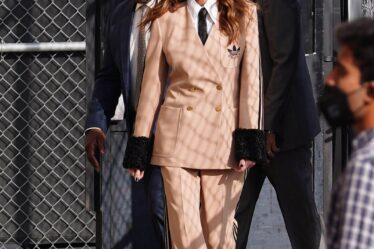
In March, Dries Van Noten debuted his beauty line — the first major new launch from the brand after it was acquired by group Spanish Puig. The collection, which features soaps, perfumes and accessories, put just one makeup product at the centre: lipstick.
Dries Van Noten’s lipsticks, encased in vibrant two-tone metal cases, with clashing prints inspired by the designer’s mainline fashion collections, are made to be seen, whether that be sitting on a dressing table, or out and about.
“Since the very beginning, we thought that we had to do objects,” said Ana Trias, Puig’s chief brands officer. “First of all, it’s about making a desirable object. There has to be something that draws your attention.”
At $78 for a case and lip colour, with refills available for $40, they also don’t come cheap. With its new lipsticks, Dries Van Noten is joining the likes of players like Hermès ($67 for a lipstick), Louboutin ($90 for a lipstick) and La Bouche Rouge ($120 for a lipstick), who are helping drive a new uber-luxury market for the makeup bag staple, justifying a premium price tag by rethinking the positioning of a lipstick from functional makeup product to enduring fashion accessory.
Lipstick was the makeup item whose sales were hit worst by the pandemic, said NPD analyst Larissa Jensen. But now, as face mask mandates lift and consumers return to socialising, demand is booming, especially at the higher end. In the US, the $400 million prestige lipstick market is growing at 44 percent year-over-year, double the rate of total makeup, according to NPD data. Sales haven’t quite recovered to pre-pandemic levels, but “there’s a lot of excitement in the category, a lot of growth, there are huge rebounds happening,” Jensen said.
Lipstick has long been a key revenue driver for designer labels in beauty, serving as a way for aspirational shoppers who can’t afford a bag or shoes to buy into a brand. At Tom Ford, where lipsticks cost about $50, the category reportedly generated $500 million in annual sales — roughly half its total — before the pandemic. Other designer fashion brands, like Dior, Chanel and Gucci, tend to see lipsticks as a much bigger piece of their business compared to most niche beauty brands, Jensen said.
Newer entrants that are playing in an ultra-luxury price segment are also finding a foothold. At British department store Selfridges, sales of lipstick over £31 ($39) have increased 35 percent this year compared with 2019, said buyer Laurie Field, with consumers buying from brands like Hermès and Dries Van Noten.
This new crop of ultra-luxe lipsticks may command sky-high prices, but products are positioned in a similar way to how luxury players approach their main core fashion and accessories businesses. Distribution is tight, with players leveraging scarcity to increase the desirability and exclusivity of products, keeping them more aspirational. Meanwhile, packaging is luxurious and lipsticks are refillable, helping pitch purchases as long-term investments rather than disposable makeup items.
“It makes sense, they’re fashion, it’s about colour, it’s about trends,” said Jensen. “They come out with lipstick in a bigger way.”
Lipstick as an Accessory
With high-end lipsticks, the product is as much about the packaging it comes in as it is the lip colour itself. Lipstick products in particular are primed to capitalise on positioning as a luxury accessory: unlike fragrances or mascara, lipstick is the one makeup item that most people will carry with them outside of their home, said Wizz Selvey, brand and retail strategist.
Those that purchase an Hermès lipstick receive the product in one of the brand’s signature orange boxes — the same ones used to house its famous bags and scarves — complete with a canvas dust bag for protection. At La Bouche Rouge, lipstick tubes are leather and come in an array of colours, each made in France and complete with what the brand calls its “signature saddle stitch,” making it easily identifiable. (Earlier this year, La Bouche Rouge raised $10 million series A from Mirabeau Asset Management — the private equity fund of Chanel heir David Wertheimer — Chalhoub Group and existing investor BPI.)
“From a customer point of view, if you’re buying into something designer, often you want it to be seen, which is why people buy it, to show it off,” Selvey said. “However people are using it, they can take it out and about with them, they’re getting it out multiple times a day, and feel good when they’re using it.”
The Lipstick Opportunity
It helps, of course, that names like Hermès and Puig-backed Dries have high levels of name-brand recognition and ample cash reserves to invest in the development and promotion of new lines. But regardless of whether you’re a legacy brand or a startup, it’s an attractive market to invest in: not only is the sector growing, but the total addressable market for brands playing in the premium segment is vast.
“You’ve definitely got your aspirational, younger consumer that might not be quite there yet to buy the full fashion range or handbag. But also it’s an accessory: if you love Louboutin shoes, you’re probably going to buy into a lipstick as well,” said Selvey. “You’ve got multiple customer demographics.”
This is the case at Dries Van Noten. Since beauty launched in stores in March, the brand has seen a higher footfall of younger, first-time customers purchasing the line alongside existing, older clients, said Puig’s Trias.
Even as consumers face increasing economic pressure, with the prospect of a recession looming large, it’s unlikely to dent their appetite for the most desirable lip products on the market — even if they come with a three-figure price tag. In the US, consumers earning over $100,000 make up the largest shopper base of prestige beauty, said Jensen. From that perspective, the customer base of high-end beauty tends to be more insulated from the inflationary pressures lower-income consumers are facing.
Plus, as prices for designer accessories skyrocket, entry-level bags and shoes become more considered purchases for middle-class consumers. They may not be able to stretch to buy a new Gucci bag, but a $70 Hermès lipstick will still feel like an indulgence.
“In the scheme of things, you talk about a $75 lipstick, you can’t compare that to an $8,000 huge screen TV, or a $5,000 pair of shoes. It still is that affordable luxury,” said Jensen. “That’s the keyword, right? It’s a luxury. There’s no denying that, but it’s way more affordable than some of these other luxuries out there.”



